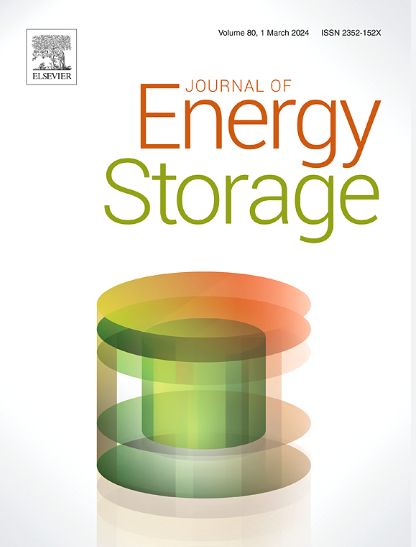锂离子电池热管理:基于液体冷却和多目标优化的主动温度控制策略的实验验证模型
IF 8.9
2区 工程技术
Q1 ENERGY & FUELS
引用次数: 0
摘要
在过去十年中,电动汽车(ev)在运输部门获得了相当大的关注,因为它们代表了短期内减少二氧化碳排放的有效解决方案,有助于到2050年实现净零排放。尽管电动汽车技术已经达到了良好的可靠性水平,但主要与锂离子存储系统及其热管理相关的挑战仍然存在。设计合理的电池热管理系统(BTMS)旨在将锂电池保持在最佳温度范围内,以保持其循环寿命耐久性、性能和安全性。因此,研究人员致力于改善和优化汽车电池组的热管理解决方案。在这项工作中,设计和开发了一种用于锂离子电池的主动间接液体BTMS,其主要目标是满足存储电池的热需求,同时也关注BTMS性能和整体系统效率之间的最佳平衡。特别是,设计和建立了一个实验室测试台,以便进行实验测试,重点是电池电热模拟模型的参数识别/验证及其温度管理。在不同的环境温度和电气工况下进行了实验测试和模拟。特别地,在冷却和加热操作过程中对所提出的BTMS进行了分析,显示出在管理冷却剂流量以达到温度设定点方面的良好行为。从验证的仿真模型出发,采用离线多目标优化程序,合理设置实际工况下的温控参数。所得结果表明,所提出的模拟模型在拟合电池在不同工作条件下的电热行为方面具有良好的可靠性。此外,BTMS可以适当地管理冷却剂流量以达到温度设定点。最后,与未优化的解决方案相比,提出的优化程序允许泵能耗的相关减少。本文章由计算机程序翻译,如有差异,请以英文原文为准。
Thermal management of Li-ion batteries: Experimentally validated model of active temperature control strategies with liquid cooling and multi-objective optimization
In the last decade, electric vehicles (EVs) have gained considerable attention in the transport sector as they represent a valid solution for reducing CO2 emissions in the short term, contributing to the achievement of net zero emissions by 2050. Despite the technology of EVs has reached a good level of reliability, challenges related mainly to the Li-ion storage systems and to their thermal management, are still open. A properly designed battery thermal management system (BTMS) is intended to maintain the lithium battery within its optimal temperature range to preserve its cycle-life durability, performance, and safety. Research efforts are, therefore, addressed to improve and optimize thermal management solutions for vehicle battery packs.
In this work, an active indirect liquid BTMS for a Li-ion cell is designed and developed with the main goal of satisfying the thermal requirements of the storage cell, by also focusing on an optimal balance between BTMS performance and overall system efficiency. In particular, a laboratory test bench was designed and set-up to allow experimental tests focused on parameter identification/validation of an electro-thermal simulation model of the cell and on its temperature management.
Experimental tests and simulations were performed for different environmental temperatures and electric operating conditions. In particular, the proposed BTMS was analyzed during both cooling and heating operations showing a good behavior in managing the coolant flow rate to achieve the temperature set-point. Starting from the validated simulation model, an off-line multi-objective optimization procedure was carried out to properly set up the temperature control parameters on real driving conditions.
The obtained results show a good level of reliability of the proposed simulation models in fitting the electro-thermal behavior of the cell under tests in different operative conditions. In addition, the BTMS can properly manage the coolant flow rate to achieve the temperature set-points. Finally, the proposed optimization procedure allows a relevant reduction in the pump energy consumption in comparison with non-optimized solutions.
求助全文
通过发布文献求助,成功后即可免费获取论文全文。
去求助
来源期刊

Journal of energy storage
Energy-Renewable Energy, Sustainability and the Environment
CiteScore
11.80
自引率
24.50%
发文量
2262
审稿时长
69 days
期刊介绍:
Journal of energy storage focusses on all aspects of energy storage, in particular systems integration, electric grid integration, modelling and analysis, novel energy storage technologies, sizing and management strategies, business models for operation of storage systems and energy storage developments worldwide.
 求助内容:
求助内容: 应助结果提醒方式:
应助结果提醒方式:


